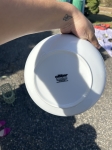Interesting weeds
Epipactis helleborine comes from the Middle East & southeastern Europe. It was first discovered near Syracuse, NY, in the 1860's, and it has since spread. I have found it in a garden in Chatham (2013), and more recently on Colonial Terrace in Maplewood (2019). Where did you find this one?
It is quite variable. In my field guide, flowers are well spaced on the stem, and the bracts are small. In this photo (and the ones I have seen), flowers are densely packed and the bracts are very long.
Both are in South Orange near Seton Hall. There are a few patches of the Epipactis, I assume they hitchhiked in a potted plant because I haven’t seen any others in the area.
I’m surprised there hasn’t been more cross breeding done with these to get larger flowers, they would make a nice garden plant.
Looking at the flower development, the plants obviously rely on pollination by long- nosed/beaked critters (certain insects, small birds, skinks etc).
Any idea if the plants spread more easily via spores on wind/spores on fresh (rain) water, run-off etc or via small animal dispersal? Controlling so-called exotic plants can feel so futile, sometimes.
Most orchid species have evolved in tandem with a specific pollinator (thus preventing cross breeding with other species). This Epipactis has obviously found a new pollinator here, unless the original pollinator from it's home range has immigrated too.
Seeds are tiny, normally spread on the wind, but they can also hitchhike on muddy boots, car wheels, etc.
Apparently this is one of the few species, which can germinate without the assistance of a fungus. Thus, it is impossible to control.
Looks like the Toadflax is mostly pollinated by bumblebees and is toxic to livestock.
The orchid seems to have a variety of pollinators, bees, wasps, flies, even aphids.
Both look to have seeds spread by wind.
I have many Epipactis helleborine in my yard. Took me years to figure it out what it was a few years ago.
I'm positive I pulled some epipactis helleborine from my shady yard this morning. Now I'll have to pay more attention when weeding. I've been assuming they are another weed that spreads both through seeds and tubers underground.
Thanks for that info!
I'm curious, because now that bees have their mite challenges, that somewhat changes the picture on how pollination occurs. Another thing to consider with very persistent weeds, that took generations to work out over here, is that sometimes fiddling with the roots of the plants actually stimulates further generation! You think you've got all the plant out of the soil, you think you've controlled for all the pollen and seed; but in digging around trying to shift the roots you've stimulated all the very ultrafine hairlike tendril roots to cling a little firmer, and if left behind they'll sprout on their own.
This is a protection against grazing cattle etc. 
Is the Linaria vulgaris what you sometimes see by the side of the road, which we called "Butter and Eggs" when I was a kid? It's hard to tell the size of the flowers from the picture.
Butter and eggs was smaller with fewer flowers on a stalk. Haven’t seen that flower in a long time.
finnegan said:
Is the Linaria vulgaris what you sometimes see by the side of the road, which we called "Butter and Eggs" when I was a kid? It's hard to tell the size of the flowers from the picture.
We have/had a similar weed or wildflower! I wonder if @marksierra remembers what we called it? Tiny flowers. (Not butter-and-eggs, not scrambled-eggs, maybe bacon-and-eggs plant? We always thought it was a kind of clover weed even though the leaves weren't true clover)
I was wrong. Googled butter and eggs and found it is linaria vulgaris. Used to see it along the roadside in Maine. Finngan you were right.
galileo said:
Butter and eggs was smaller with fewer flowers on a stalk. Haven’t seen that flower in a long time.
My memory matches yours galileo, both that there were fewer flowers on the stalk and that they used to be common but not so much these days. So I checked Wikipedia, and apparently butter and eggs is one of the (many) common names of Linaria vulgaris: https://en.wikipedia.org/wiki/Linaria_vulgaris
And, joanne, Wikipedia did reference eggs and bacon, but it is another flower altogether: https://en.wikipedia.org/wiki/Lotus_corniculatus
thanks for your research - given its invasive nature and exotic origin, that's probably why we rarely see it nowadays. Would have been extensively campaigned for eradication and replaced by more suitable fodder and erosion-reducing plants. 
(Pity, because seeing a wild border of them was always pretty)
Rentals
For Sale
Garage Sales
-
Hilton/Lightening Brook Neighborhood Garage Sale October 19th Sale Date: Oct 19, 2024
More info





















Both are considered invasive weeds and both are from Europe.
First is Epipactis helleborine, a European terrestrial orchid.
Second Linaria vulgaris, “Toadflax” related to snapdragons, the lower petals are hinged and open like a mouth.